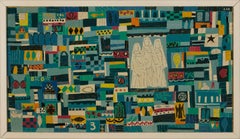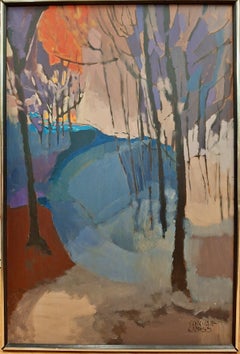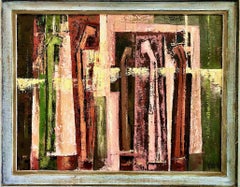Alice Musicant Paintings
to
1
Overall Width
to
Overall Height
to
1
1
1
1
1
1
1
1
781
716
711
692
1
1
Artist: Alice Musicant
"The Three Nuns"
By Alice Musicant
Located in Lambertville, NJ
Jim’s of Lambertville is proud to offer this artwork.
Signed upper right.
Category
20th Century Abstract Alice Musicant Paintings
Materials
Masonite, Oil
Related Items
A Summer's Sunset
Located in San Francisco, CA
In this abstract landscape, artist Geneva Cross conveys the mood of a dreamlike summer evening that might be remembered by any of us in its universality. Blending the basic elements ...
Category
1970s Abstract Alice Musicant Paintings
Materials
Masonite, Oil
An Abstract Geometric "Men of Matthew"
Located in San Francisco, CA
It’s time to bury the so-last-century idea that folks are either "right-brained,” i.e., naturally creative, or (boringly) "left-brained," always operating logically. And here’s just ...
Category
1950s Abstract Geometric Alice Musicant Paintings
Materials
Masonite, Oil
'Abstract Landscape', by Katherine Westphal, Oil on Board
Located in Oklahoma City, OK
Katherine Westphal's oil on board painting titled 'Abstract Landscape' embodies the stylistic qualities of abstract painting. Using a diverse color palette of orange, red, yellow, bl...
Category
Mid-20th Century Abstract Alice Musicant Paintings
Materials
Masonite, Oil
$1,840 Sale Price
20% Off
H 24.25 in W 30.25 in D 0.875 in
Reclining Nude
Located in Wilton Manors, FL
Edwin Kosarek (b.1929). Reclining Nude, 1952. Oil on wood panel, 17 x 48 inches. Signed and dated on verso.
Edwin Kosarek
Born: 1929
Studied: The Cit...
Category
Mid-20th Century Abstract Alice Musicant Paintings
Materials
Masonite, Oil
"Crossed Arms" Mid Century Abstract Expressionist NYC Female Artist
By Sylvia Rutkoff
Located in Arp, TX
Sylvia Rutkoff (1919-2011)
Sr5-1
c.1960s
“Crossed Arms”
Acrylic on Masonite
36x42 period frame
Unsigned
Collection acquired from family estate
Category
Mid-20th Century Abstract Expressionist Alice Musicant Paintings
Materials
Masonite, Oil
$4,000
H 36 in W 42 in D 2 in
Rock Candy Mountain (unique, signed Abstract Expressionist painting) framed 70s
By Ben Wilson
Located in New York, NY
Ben Wilson
Rock Candy Mountain, ca. 1970
Oil on masonite board (Hand Signed, titled and dated)
Hand signed, titled and dated by Ben Wilson on the back
Frame Included: held in artist'...
Category
1970s Abstract Expressionist Alice Musicant Paintings
Materials
Masonite, Oil, Permanent Marker
$7,000
H 25 in W 49 in D 1 in
Ozymandias (unique, signed Abstract Expressionist painting by renowned painter)
By Ben Wilson
Located in New York, NY
Ben Wilson
Ozymandias, 1989
Oil on masonite board
Boldly signed by Ben Wilson on the back
36 × 48 inches
Unframed
Provenance: acquired from the Estate of Ben Wilson
This work is titled "Ozymandias" after the famous sonnet written by Percy Bysshe Shelley (1792-1822). Shelley's poem is one of the most poignant meditations on the fleeting nature of human power and the inevitability of decline. The poem serves as a reminder that time erodes even the most imposing empires and leaders and that the pursuit of lasting fame and control is ultimately futile.
Depending on how one views Ben Wilson's Abstract Expressionist painting of "Ozymandias" -- some of the imagery might reveal the head of an angry king and a sickle.
Shelley's poem Ozymandias reads:
I met a traveler from an antique land...
Category
1980s Abstract Expressionist Alice Musicant Paintings
Materials
Masonite, Oil
$7,500 Sale Price
50% Off
H 36 in W 48 in D 0.3 in
Edge
Located in Austin, TX
Waterline Fine Art, Austin, TX is pleased to present the following work:
Oil on board. Signed and dated lower right and verso, titled verso.
36.25 x 48 in.
40.5 x 52.25 in. (framed)
Framed in contemporary silver, tiered floater frame.
Dennis Eugene Norman Burton was a Canadian modernist who was born in Lethbridge, Ontario. He attended the Ontario College of Art from 1952 to 1956, and worked for the Canadian Broadcasting Corporation (CBC) as a graphic designer until 1960.
Inspired by a 1955 exhibition of the “Painters Eleven” at Toronto’s Hart House, as well as American Abstract Expressionist artists such as Robert Motherwell, Jack Tworkov, and Willem de Kooning, Burton shifted his focus toward abstraction in the mid-1950s.
Burton showed with the famed Isaacs Gallery in Toronto, becoming one of the youngest members on the gallery’s roster. A talented musician, he also played saxophone in the Artist’s Jazz Band in Toronto - a pioneering Canadian free-jazz group...
Category
1950s Abstract Expressionist Alice Musicant Paintings
Materials
Masonite, Oil, Board
Byzantium, original signed painting by renowned Abstract Expressionist, Framed
By Ben Wilson
Located in New York, NY
Ben Wilson
Byzantium, 1975
Oil on Masonite painting
Hand signed reverse, Titled, "Byzantium", dated 1975 by the artist and also with estate stamp - in addition to Ben Wilson's hand s...
Category
1970s Abstract Expressionist Alice Musicant Paintings
Materials
Masonite, Oil
$12,000
H 19.5 in W 16.5 in D 1.5 in
Untitled Series (six paintings)
Located in Wilton Manors, FL
A series of six abstract painting by American artist, Edward Pechmann Renouf (1906-1999). Oil on six individual masonite panels, each panel meas...
Category
1970s Abstract Expressionist Alice Musicant Paintings
Materials
Masonite, Oil
Harbor abstract in Deep Blues
By Donald Roy Purdy
Located in New York, NY
Signed lower left: Purdy
A very cool example of mid-century 50"s abstraction. Harbor is done in a style that was being experimented with particularly in the New York and California ...
Category
Mid-20th Century Abstract Alice Musicant Paintings
Materials
Oil, Masonite
Original Leonardo Nierman Abstract Painting Oil on Masonite Framed Purple
By Leonardo Nierman
Located in Buffalo, NY
An original oil on masonite painting by well listed Mexican artist Leonardo Nierman.
This work comes in a unique gold frame presentation which is likely original to the piece.
Si...
Category
1960s Abstract Expressionist Alice Musicant Paintings
Materials
Masonite, Oil
$3,116 Sale Price
20% Off
H 30 in W 24 in
Alice Musicant paintings for sale on 1stDibs.
Find a wide variety of authentic Alice Musicant paintings available for sale on 1stDibs. You can also browse by medium to find art by Alice Musicant in masonite, oil paint, paint and more. Much of the original work by this artist or collective was created during the 20th century and is mostly associated with the abstract style. Not every interior allows for large Alice Musicant paintings, so small editions measuring 25 inches across are available. Customers who are interested in this artist might also find the work of Lamar Briggs, Edward Avedisian, and Dan Teis. Alice Musicant paintings prices can differ depending upon medium, time period and other attributes. On 1stDibs, the price for these items starts at $7,450 and tops out at $7,450, while the average work can sell for $7,450.


